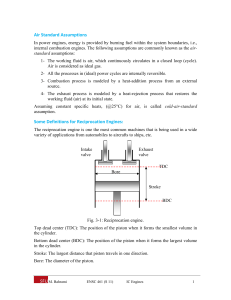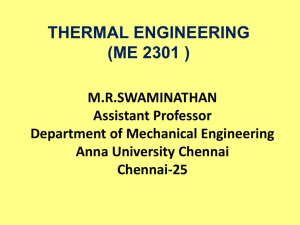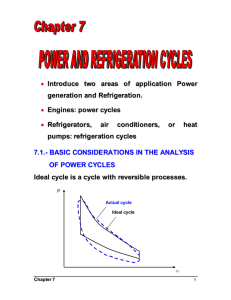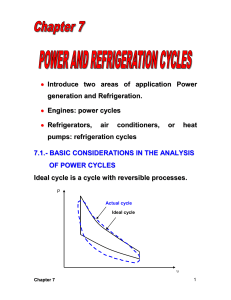Air Standard Assumptions
advertisement
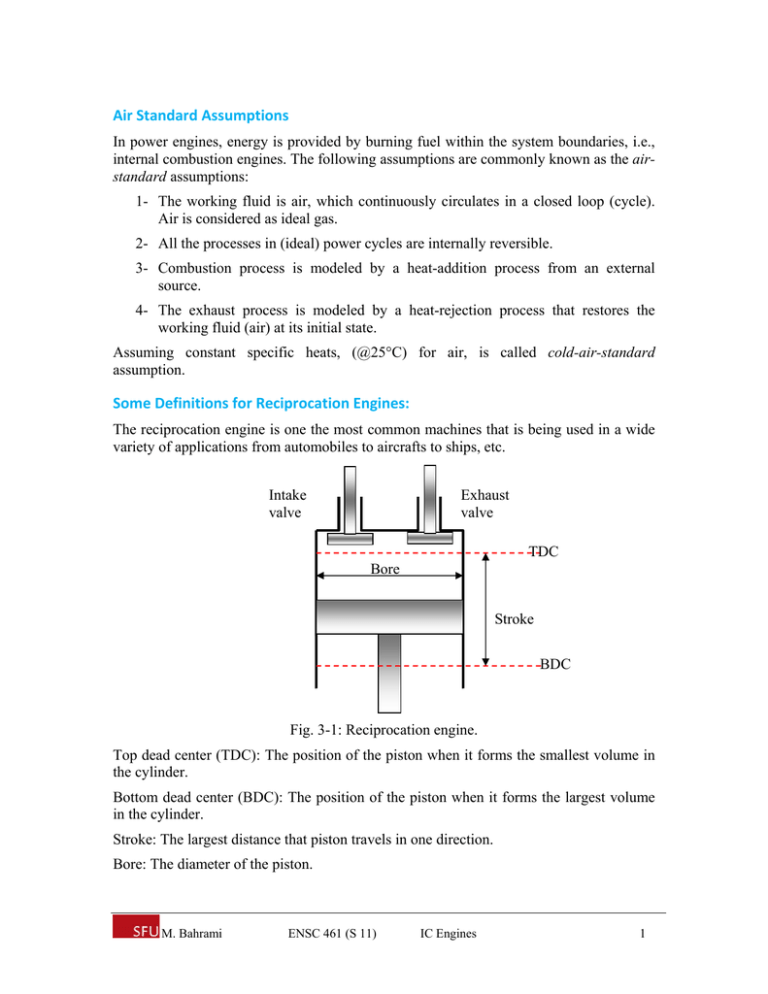
Air Standard Assumptions In power engines, energy is provided by burning fuel within the system boundaries, i.e., internal combustion engines. The following assumptions are commonly known as the airstandard assumptions: 1- The working fluid is air, which continuously circulates in a closed loop (cycle). Air is considered as ideal gas. 2- All the processes in (ideal) power cycles are internally reversible. 3- Combustion process is modeled by a heat-addition process from an external source. 4- The exhaust process is modeled by a heat-rejection process that restores the working fluid (air) at its initial state. Assuming constant specific heats, (@25°C) for air, is called cold-air-standard assumption. Some Definitions for Reciprocation Engines: The reciprocation engine is one the most common machines that is being used in a wide variety of applications from automobiles to aircrafts to ships, etc. Intake valve Exhaust valve TDC Bore Stroke BDC Fig. 3-1: Reciprocation engine. Top dead center (TDC): The position of the piston when it forms the smallest volume in the cylinder. Bottom dead center (BDC): The position of the piston when it forms the largest volume in the cylinder. Stroke: The largest distance that piston travels in one direction. Bore: The diameter of the piston. M. Bahrami ENSC 461 (S 11) IC Engines 1 Clearance volume: The minimum volume formed in the cylinder when the piston is at TDC. Displacement volume: The volume displaced by the piston as it moves between the TDC and BDC. Compression ratio: The ratio of maximum to minimum (clearance) volumes in the cylinder: r Vmax VBDC Vmin VTDC Mean effective pressure (MEP): A fictitious (constant throughout the cycle) pressure that if acted on the piston will produce the work. Wnet = MEP x APiston x Stroke = MEP x Displacement vol. MEP Wnet Vmax Vmin kPa An engine with higher MEP will produce larger net output work. Internal Combustion Engines 1. spark ignition engines: a mixture of fuel and air is ignited by a spark plug applications requiring power to about 225 kW (300 HP) relatively light and low in cost 2. compression ignition engine: air is compressed to a high enough pressure and temperature that combustion occurs when the fuel is injected applications where fuel economy and relatively large amounts of power are required M. Bahrami ENSC 461 (S 11) IC Engines 2 Spark‐Ignition (Gasoline) Engine Spark Combustion products Air +Fuel Compression stroke (1-2) Power (expansion) stroke (2-3) Exhaust stroke (3-4) Intake stroke (4-1) Fig. 3-2: Actual cycle for spark-ignition engines, four-stroke. v Fig. 3-3: P-v diagram for spark-ignition engines. Otto Cycle The Otto cycle is the ideal cycle for spark-ignition reciprocating engines. It serves as the theoretical model for the gasoline engine: Consists of four internally reversible processes Heat is transferred to the working fluid at constant volume The Otto cycle consists of four internally reversible processes in series: M. Bahrami 1-2 Isentropic compression 2-3 Constant-volume heat addition ENSC 461 (S 11) IC Engines 3 3-4 Isentropic expansion 4-1 Constant-volume heat rejection P T 3 3 Isentropic Qin v = Const. 2 4 2 Isentropic Qout 1 v = Const. 4 1 s v TDC BDC Fig. 3-4: T-s and P-v diagrams for Otto cycle. The Otto cycle is executed in a closed system. Neglecting the changes in potential and kinetic energies, the 1st law, on a unit mass base, can be written: qin qout win wout u kJ / kg where qin u 3 u 2 cv T3 T2 q out u 4 u1 c v T4 T1 Thermal efficiency can be written : w q T T T T / T 1 th,Otto net 1 out 1 4 1 1 1 4 1 qin qin T3 T2 T2 T3 / T2 1 Processes 1-2 and 3-4 are isentropic, and v2 = v3 and v4 = v1. Thus, T1 v 2 T2 v1 k 1 th,Otto 1 v 3 v4 1 k 1 T4 T3 r k 1 where r is called the compression ratio: r Vmax V1 v1 Vmin V2 v 2 Typical compression ratios for spark-ignition engines are between 7 and 10. The thermal efficiency increases as the compression ratio is increased. However, high compression ratios can lead to auto ignition or engine knock. M. Bahrami ENSC 461 (S 11) IC Engines 4 Diesel Engine The Diesel cycle is the ideal cycle for compression ignition engines. It is very similar to spark-ignition, expect the method of ignition. In diesel engine, air compressed to a temperature that is above the ignition temperature of the fuel. P T 3 3 2 Qin Isentropic P = Const. 4 2 P = Const. 1 4 Isentropic Qout 1 s v TDC BDC Fig. 3-5: T-s and P-v diagram of Diesel engine. The thermal efficiency of the Diesel engine under the cold air standard assumptions becomes: th, Diesel wnet 1 r k 1 1 k 1 c qin r k rc 1 1 for Otto where V v r max 1 Vmin v 2 We also define the cutoff ratio rc, as the ratio of cylinder volumes after and before the combustion process (ignition period): rc V3 v3 V2 v 2 Comparison of the Otto and the Diesel Cycle ηOtto > ηDiesel for the same compression ratio Diesel engines burn the fuel more completely since they usually operate at lower rpm and air-fuel ratio is much higher than ignition-spark engines Diesel engines compression ratios are typically between 12 and 24, whereas spark-ignition (SI) engines are between 7 and 10. Thus a diesel engine can tolerate a higher ratio since only air is compressed in a diesel cycle and spark knock is not an issue M. Bahrami ENSC 461 (S 11) IC Engines 5 Dual Cycle (Limited Pressure Cycle) Combustion process in internal combustion engines either as constant-volume (Otto cycle) or constant-pressure (Diesel cycle) heat addition is overly simplified and it is not realistic. dual cycle is a better representation of the combustion process in both the gasoline and the diesel engines both the Otto and the Diesel cycles are special cases of the dual cycle. P 4 T 3 P = Const. QH,2 4 QH,1 3 v = Const. 5 2 5 2 v = Const. 1 Isentropic Isentropic 1 s Fig. 3-6: T-s and P-v diagrams for an ideal dual cycle. Defining: r v1 Compression ratio v2 rc v4 Cutoff ratio v3 rp P3 Pressure ratio P2 The thermal efficiency of the dual cycle becomes : Dual 1 r rp rck 1 p 1 krp rc 1 r k 1 Note that when rp =1, we get the Diesel engine efficiency. M. Bahrami ENSC 461 (S 11) IC Engines 6
